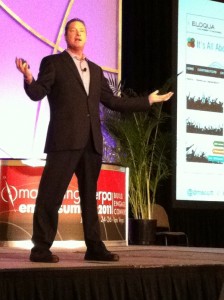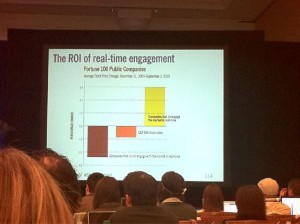In November 1999, I woke up abruptly at about 3 a.m. in a hotel room outside Phoenix where I was attending a marketing conference.
I’d had this strangely intense dream. The vision was so overwhelming that I fumbled in my bag next to the bed for a pen and paper and started furiously scribbling.
The result: a blueprint outlining every aspect of what would become MarketingSherpa — an encyclopedic resource with practical research data, inspirational real-life samples and instructional how-to to help marketers get better results.
I’ve kept that piece of paper tacked up on my office bulletin board all these years. Although the ink is now faded, it still inspires me.
Today, at long last, we’re officially launching beta versions of not one but five major new services all initially envisioned in that dream:
#1. MarketingSherpa Membership Beta
Many of you have emailed and called over the years to complain that buying Case Studies one at a time was inconvenient. Now that pain has ended. When you join as a Sherpa Member, you’ll get complete access to everything year-round, including 744+ Case Studies and 526 how-to pieces.
And, yes, we’ve improved search and added 52 topical microsite sections so it’s easier to quickly find what you need.
#2. Research Database Beta
I’ve had a team of four, headed by a research librarian, working behind the scenes for more than a year now to make this for you. They’ve created more than 2,000 searchable records of every type of research to do with marketing, ads and PR from more than 500 organizations.
If you’re looking for a number, chances are you’ll find a source referenced in this handy, ever-growing database.
#3. Creative Samples Library Beta
We’ve gathered, organized and cross-referenced more than 2,200 creative samples from MarketingSherpa Case Studies into a searchable library for you. Each one includes hotlinks back to the original story so you can see how effective the campaign was.
Yes, you can search by brand name so you can see what we have for your company and your competitors.
#4. Awards Calendar Beta
A personal favorite of mine, we track 254 different awards in marketing, ads and PR throughout the year. It’s easy to search by topic, location and — most importantly –nomination deadlines!
#5. Events Calendar Beta
Many of you write in asking if we know of good events for marketing professionals to attend, sponsor or speak at. That’s why our research team created this calendar for you tracking 577 events and trade shows throughout the year.
You may be wondering why all of this is called “Beta.”
I stole the idea from Google, who call lots of their new services Beta. Beta to me means that I’m very much looking for your input as you try the new services so we can improve them further. You understand the site is not locked in stone, but rather a work in progress based on your feedback and demand.
It also means that as a Beta user, you’re one of the first. Some people don’t like being first; others really do. The choice is in your hands. You can learn more at:
https://www.marketingsherpa.com/membertour.html
In closing, all this weekend I thought a lot about the past seven and a half years — what an incredible journey it’s been from that waking up alone in that hotel room with a Big Idea to an office packed with researchers and reporters working to make it a reality.
So, I’d like to quickly thank some people for their help along the way:
o Andy Bourland, Founder ClickZ, and Dr. Flint McGlaughlin, Director MarketingExperiments, for sending in two of Sherpa’s very first reader testimonials years ago.
o Aimee Kessler Evans, employee No. 1 and now one of our very first Beta Members.
o Tad Clarke, our editorial director, for leaving his decade-long position at DM News and moving from Manhattan to Rhode Island to take a chance with Sherpa.
o Stefan Tornquist, our research director, for making the exact opposite move so we’d have a New York-based research presence.
o Reporters past and present, especially including Jennifer Nastu, Mark Brownlow, Dianna Huff, Alexis Gutzman, Chris Heine and Sean Donahue.
o Longstanding team members Sharon Hamner, Ron Perry, Aimee Croke, Kim Pezzetti, Terra Hughes, Meinhart & Associates and the guys in our Sombor, Serbia, branch office.
o Newer Sherpas including Cintia Miranda, who’s taken on the, perhaps, daunting task of running the marketing department.
o All the programmers and designers from Matrix Group to CVanek Studios, who made the site’s evolution possible. Plus, Holly Hicks on the newsletters front.
o Tech suppliers, including Omniture, ExactTarget, WebSideStory Search, Kowabunga and SurveyGizmo, who make our services possible.
o Hope Hopkins, Membership Services Producer, and Erin Donovan, Research Librarian. To you two falls the now even bigger task of keeping our new services growing healthy and strong.
And, last, but overwhelmingly not least, you, our 237,000 weekly readers, who have made this incredible journey possible — and who give us the reason to keep on building a newer, better Sherpa every single day.
Thank you for your support and guidance.













